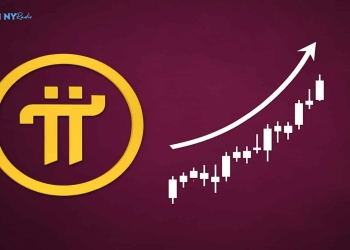In the sphere of finance, two assets stand as titans in their respective realms—gold and Bitcoin. Both have witnessed notable inflows and price escalations in recent times, stirring excitement among investors. Yet, for Bitcoin to shatter its all-time high peak, experts propose that the ongoing gold ascent may necessitate a short-term respite. Ancient patterns give perception into this happening, and new figures from exchange-traded funds (ETFs) further back this notion.
Gold’s Epic Ascent: Setting the Stage for Bitcoin?
Within the past seven trading sessions, in excess of 1 million ounces of gold have streamed into ETFs—signalling the most significant influx since October 2022. This surge signals reinvigorated investor confidence in gold, particularly as the precious metal maintains its robust overall performance, rising over 37% this year. It’s not just gold making headlines; silver has also seen significant gains, climbing 43% year-to-date and hitting a 12-year tall.
Gold’s present ascent echoed its behaviour in 2020 when it led the market ahead of Bitcoin’s explosive advancement. Back then, gold climbed to record highs by August 2020, while Bitcoin remained in a prolonged consolidation phase. However, as gold’s momentum flagged toward the end of the year, Bitcoin surged from $10,000 to $60,000 in just a few months, establishing itself as a major asset in the financial markets.
Bitcoin’s All-Time High: Will Gold’s Cool Down Unleash BTC’s Potential?
Given the historical parallels between gold and Bitcoin, some analysts believe that Bitcoin’s next surge could come on the heels of a pause in gold’s relentless climb. In 2020, Bitcoin appeared content to wait until gold exhausted its momentum before embarking on its own epic journey upward. While Bitcoin has traded in a range between $50,000 and $70,000 this year, breaking new peaks has so far eluded it, limited by macroeconomic factors and regulatory fog surrounding crypto.
Gold’s eye-catching surge past $2,700 stemmed from multifaceted drivers—inflation jitters and geopolitical strain spurred demand for safe assets. Experts note that gold shows no signs of slowing but speculate its rally may eventually tap the brakes, priming Bitcoin to break free of its holding pattern. Should gold pull back even briefly, might this provide tailwinds allowing Bitcoin to soar to new highs? Only time will tell.
ETF Inflows: A Sign of What’s to Come?
Both gold and Bitcoin have experienced huge ETF inflows recently, revealing investors flocking to these investment vehicles for exposure. U.S. Bitcoin ETFs gained $2 billion over seven days, with the iShares Bitcoin Trust alone attracting $1.7 billion. In that span, gold ETFs added over 1 million ounces—their strongest session since October 2022.

Data from Farside shows U.S. spot Bitcoin ETFs witnessed $192.4 million of net inflows as of October 23. Similarly, iShares Bitcoin Trust recorded impressive $317.5 million flows, ballooning assets to a mammoth $23.5 billion. This surge in demand indicates a growing institutional and retail appetite for inflation-resistant, high-growth holdings.
The Role of Stablecoin Liquidity and Bitcoin Transactions in the Upcoming Surge
Another contributing factor to Bitcoin’s potential breakthrough is the rise in stablecoin liquidity and transactions on the Bitcoin network, a phenomenon nicknamed “Uptober” in the crypto community. Stablecoins, which offer a more reliable store of value than volatile cryptocurrencies, have observed increased usage in trading pairs with Bitcoin, driving liquidity and supporting price growth. Higher transaction volumes on the Bitcoin network also point to growing activity, indicating renewed investor interest in the cryptocurrency as it hovers near its three-month high of $67,000. With more capital flowing into the market and Bitcoin ETFs acting as a “Trojan horse” for broader adoption, according to Bernstein analysts, Bitcoin could be setting the stage for a significant rally once external pressures subside.
Gold versus Bitcoin: A Battle of Risk-Adjusted Returns
While Bitcoin has climbed 40% year-to-date, it still underperforms gold when adjusted for risk. This may seem surprising to those who view Bitcoin as a high-growth asset, but it underscores the challenges the cryptocurrency faces in reaching new highs. Gold, with its centuries-long history as a safe-haven asset, offers lower volatility and has benefited from its perception as a stable store of value during times of economic uncertainty.
However, Bitcoin’s upside potential is vastly greater in the long run, especially as institutional adoption expands and new applications for the technology continue emerging. Investors may be holding their breath, waiting for the next major catalyst—whether it’s the conclusion of the gold rally or another macroeconomic shift—to propel Bitcoin past its previous records.
What’s Next for Bitcoin?
As election season draws nearer, cryptocurrency traders are hopeful that Bitcoin may reach new all-time highs once political uncertainty dissipates. The combination of growing exchange-traded fund inflows, rising transaction volumes across the blockchain, and enhanced liquidity in bitcoin markets suggests that the leading digital asset is primed for a momentous price surge. However, much depends on how long the ongoing rally in gold persists. If trends from the past repeat, a pause in the yellow metal’s ascent could provide the opening Bitcoin requires for its next landmark value ascent.
In the interim, investors will monitor both assets closely, scouring each for signs that the tides may soon turn. It remains uncertain whether Bitcoin will continue shadowing gold’s movements, but one reality is clear: both stand poised to profoundly impact the emerging financial landscape in the quarters ahead. Complex relationships between storied stores of value like gold and emerging innovations like Bitcoin will inevitably shape markets and geopolitics going forward.
Stay connected with TurkishNY Radio by following us on Twitter and LinkedIn, and join our Telegram channel for more news.




























































































![BitTorrent [New]](https://s2.coinmarketcap.com/static/img/coins/64x64/16086.png)



















